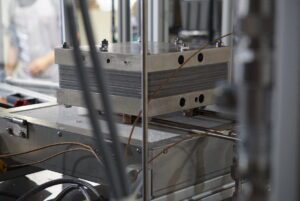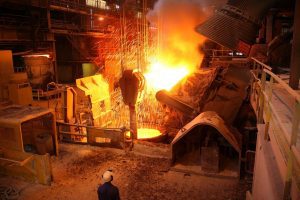Over the past few years, engineers from both companies have jointly developed sLH2, a new process for handling sub-cooled liquid hydrogen. When compared to gaseous hydrogen, this innovative approach allows for a higher storage density, a greater range, faster refueling, lower costs and superior energy efficiency. Refueling takes around 10–15 minutes for a 40-ton heavy-duty truck carrying 80 kg of LH2 for a range of 1,000 kilometers and more. At the same time, the new sLH2 technology lowers the required investment for a hydrogen refueling station by a factor of two to three, and operational costs are five to six times lower.
Compared to regular LH2 refueling technology, the new process uses a new innovative sLH2 pump to slightly increase the pressure of the liquid hydrogen. With this method, the hydrogen becomes sub-cooled liquid hydrogen. Hydrogen in this state facilitates a very robust fueling process that also keeps energy losses during refueling to a minimum. Furthermore, no data transmission between the refueling station and vehicle is necessary, which further reduces the complexity of the solution. At the same time, refueling capacity is increased to new levels. The pilot refueling station has a capacity of 400 kg of LH2 per hour. In comparison to regular liquid or gaseous hydrogen refueling concepts, sLH2 is considerably simpler while delivering increased performance.
The refueling station has a small footprint of just 50 m² (not including the dispenser) and allows for configurations where several dispensers for parallel refueling of trucks are possible, as well as back-to-back refueling. The liquid hydrogen storage tank has a capacity of four tons, sufficient for approximately ten hours of non-stop refueling. Meanwhile, the capacity of the sLH2 fuel station can be increased to over eight tons per day with refilling. A lower initial investment and operational costs for the sLH2 technology is expected to ultimately result in lower total cost of ownership.
Aim: setting the industry standard for LH2 refueling
Daimler Truck and Linde Engineering aim to make sLH2 the leading hydrogen refueling technology for heavy-duty trucks. As a result, both companies offer a high level of transparency and openness around the relevant interfaces of the jointly developed sLH2 technology. The technology has been standardized in an open ISO process and is available to all interested parties. Daimler Truck and Linde Engineering now call upon other OEMs, infrastructure companies and associations to apply the new liquid hydrogen standard and thereby establish a global mass market for the process.
Safe, fast and simple refueling with hydrogen
In contrast to current LH2 refueling, the sLH2 process is similar to the convenience of current diesel refueling technology. Due to robust insulation of the refueling hose and the design of the interfaces between the nozzle and fuel tank, the process is safe without the possibility of spillage. Therefore, the protective measures required for sLH2 refueling are comparable to those required for diesel. During the refueling process, cryogenic LH2 at -253°C can be filled into two connected 40 kg tanks mounted on either side of the truck chassis without the need for special safety gear. The sLH2 technology allows for high flow delivery of more than 400 kg of hydrogen per hour, and filling 80 kg of LH2 can be completed in 10–15 minutes. Finally, the new process avoids what are known as boil-off effects and ‘return gas’ (gas from the vehicle’s tank returning to the filling station), meaning that only one nozzle is needed to fill the tanks, making sLH2 technology easier to handle.
sLH2 to be implemented in Mercedes-Benz GenH2 Truck customer-trial fleet
From mid-2024 onward, five companies are expected to take part in initial customer trials to gain first experience in CO₂-free long-distance transport with Mercedes-Benz GenH2 Trucks. The semi-trailer tractors will be deployed in different long-haul applications on specific routes within Germany, and they will be refueled at the now open public sLH2 refueling station in Wörth am Rhein and at a refueling station in the Duisburg area. Daimler Truck and its partner companies are thus creating a lighthouse project aimed at demonstrating that decarbonized transport with hydrogen-powered trucks is already possible today. However, for the transformation to succeed, it will be necessary in the coming years to ensure the build-up of an international refueling infrastructure and a sufficient supply of green liquid hydrogen.
Andreas Gorbach, Member of the Board of Management of Daimler Truck AG, responsible for Truck Technology, said: “Zero-emission transport needs three factors: the right battery-electric and hydrogen-powered vehicles, the required infrastructure network and cost parity for ZEVs compared to diesel trucks. In terms of vehicles, the transformation is in full swing. In terms of hydrogen infrastructure, we are reaching a major milestone today: With sLH2, hydrogen refueling becomes as convenient as today’s refueling with diesel. It takes about 10 to 15 minutes to fuel our Mercedes-Benz GenH2 Truck for a range of more than 1,000 kilometers. We now call on other OEMs and infrastructure companies to follow our approach and jointly make this technology an industry standard.”
Juergen Nowicki, Executive Vice President Linde plc and CEO of Linde Engineering, added: “Subcooled liquid hydrogen considerably increases the efficiency of hydrogen refueling systems. The required investment is reduced by a factor of two to three, and operational costs are five to six times lower. This and further advantages make sLH2 a practical, CO₂-neutral alternative to diesel in the heavy-duty vehicle sector. The technology we have developed with Daimler Truck will help pave the way for the development of a robust refueling network, which is essential to keep vehicles moving and supply chains intact.”






